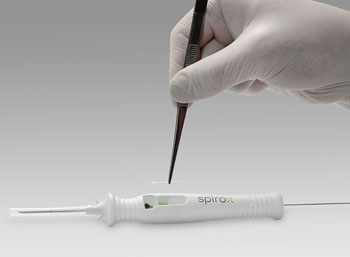Novel Implant Supports Lateral Nasal Cartilages
By HospiMedica International staff writers
Posted on 02 Aug 2016
A new nasal implant provides surgeons with a minimally invasive option for treating nasal valve collapse, a major cause of nasal obstruction.Posted on 02 Aug 2016
The LATERA absorbable nasal implant is designed to provide lateral cartilage support of the upper and lower lateral nasal cartilages. It is composed of the implant itself and an accessory delivery device and implant positioning guide that serve as an external visual aid prior to implant placement. Made of Poly (L-lactide-co-D-L-lactide) 70:30 copolymer, the implant is predominantly cylindrical in shape, with a diameter of one mm and an overall length of 24 mm. A forked distal end is intended for anchoring, while the proximal end is designed for increased flexibility.

Image: The LATERA absorbable nasal implant and delivery device (Photo courtesy of Spirox).
The single use delivery device is composed of a handle body, a deployment plunger and pushrod, and a 16-gauge delivery cannula with a depth marker and protective cover. The handle includes an implant loading port, providing an internal transition between the loading position and the cannula in order to collapse the implant forks within the cannula inner lumen prior to deployment. A product of Spirox (Menlo park, CA, USA), the implant is designed to be absorbed in the body over a period of approximately 18 months.
“We have worked with physician leaders to find a solution to a major clinical need. The research and development behind the innovation is complex, but the technique is elegant and intuitive,” said Duke Rohlen, CEO of Spirox. “LATERA gives physicians a new option to support lateral cartilage, enabling a more complete means for addressing their patients’ nasal obstruction symptoms.”
“LATERA is an important development for nasal obstruction patients when a standard procedure treating the septum and turbinates is often not enough,” said Pablo Stolovitzky, MD, of Emory University (Atlanta, GA, USA). “LATERA provides us with a minimally-invasive solution to support nasal lateral cartilage. I was able to place the implant on my first attempt, and I expect that the physician learning curve will be short.”
Nasal airway obstruction can be caused by several factors, including septal deviation, enlarged turbinates, and weakened upper and/or lower lateral nasal wall cartilage, which can lead to nasal valve collapse. The nasal valve contributes as much as 80% of total nasal airway resistance, and even minor constriction of this area results in a clinically significant impairment of nasal breathing for the patient. Nasal valvular incompetence may equal or even exceed septal deviation as the prime cause of nasal airway obstruction.
Related Links:
Spirox














